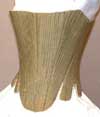
Stays, or "a pair of bodies", as they were known in the 17th century, grew out of a stiffened bodice used in women's gowns in the 15th century, either as part of the gown (minimal stiffeninng or boning) or as a separate item (more boning); as the gown bodice grew stiffer, it became more convenient to make it into a separate garment from the petticoat. When did the bodice become separated from the petticoat? It's hard to say; there are records of separate 'bodies' worn by upper class women in the mid- to late-16th century, but one still sees what might be a unified petticoat-and-bodice in genre art as late as the mid-17th century, though usually the waistline is obscured by an apron, making it hard to tell if a petticoat and bodice of the same color are joined or separate. If they are different colors (as most are), it's likely that the bodice and petticoat are separate items.
| 1550 - 1600 |
See A Concise
History of the Elizabethan Corset, by Drea Leed For a look at the minimally boned or stiffened gowns worn by the lower classes in this period, go here and here |
 |
These stays were worn by Plaszgräfin Dorothea Sabina von Neuberg, d. 1598. More details can be seen in Janet Arnold's Patterns of Fashion. The originals are at the Bayerisches Nationalmuseum, Munich. They may be a particularly German style, as they have no stiffening over the bust; German costume in this period seems to have more bust definition than the straighter lines of English and French fashions of this period. |
| 1600-1625 | |
| Elizabeth Vernon, Countess of Southampton; unknown artist, c. 1600. She is wearing a pink silk 'pair of bodies' which lace up in front. | |
 |
Bents (sea grass stiffening) used in the front of a pair of linen bodies, early 17th or rural 18th c., Rocamora Collection, Barcelona. |
| 1625-1645 | See Kass McGann's look at 17th c. stays |
| 1645 - 1680 | |
 |
Nicholas Maes, ‘The Milkwoman,’ c. 1660. "This Dutch costume is the basis of later European women’s peasant dress, with its linen shift, front-fastened bodice to which sleeves can be attached, plain skirt and straw hat. The bodice could be boned and in England was called a corset or waistcoat. The copper milk vessels and the yoke were common on both sides of the Channel." {Diane de Marly, Working Dress, p. 29} |
| 1680 - 1720 | |
| 1720 - 1770 | |
 |
Green stays, 1740-1760, sold on Ebay (click on image to see more photos of these stays) |
|
Photos
of stays, c. 1750-1760, from NWTA web site |
|
|
1769 - corset blanc (white corset), from M. Garsault's Description
des Arts et Métiers See also |
|
| 1769 - camisole (Bed jacket).
Waugh: "This is less fitting than a corset and usually ties in
front with ribbons. R is the sleeve."
This is definitely an 'undress' garment -- something worn in one's own home, not out in public. |
|
| Other online resources on stays: "Object-ively Speaking: Case Study of 18th Century Stays" by Sally A. Queen |
|
|
This busk, made of either bone or ivory, dates to around 1800 - 1810 and is approximately 9" long by about 1" wide. Photo courtesy of Leila Hidic of Corsets and Crinolines. Other Busks: |
|
![]()


